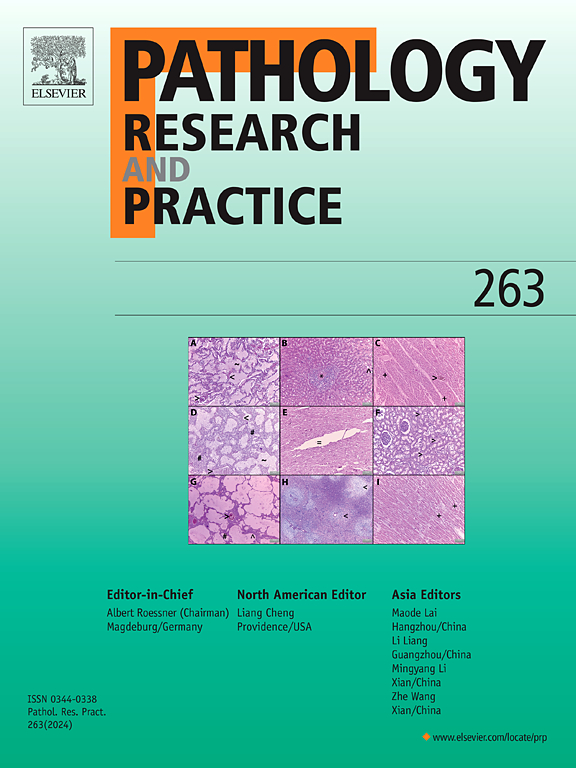非编码rna的遗传和表观遗传调控:在癌症转移、干细胞和耐药中的意义。
IF 2.9
4区 医学
Q2 PATHOLOGY
引用次数: 0
摘要
肿瘤干细胞(Cancer stem cells, CSCs)在肿瘤的发生、发展和抵抗治疗中起着至关重要的作用。最近的研究表明,非编码rna (ncRNAs),如microRNAs (miRNAs)和长链非编码rna (lncRNAs),在控制癌症干细胞(CSCs)的特征中发挥着复杂的作用。非编码rna (ncRNAs)在控制干细胞的重要特性中起着至关重要的作用,例如它们的自我更新能力、分化成不同的细胞类型和抵抗治疗的能力。本文概述了目前对非编码rna (ncRNAs),即微rna (miRNAs)和长链非编码rna (lncRNAs)与癌症干细胞(CSCs)之间复杂关系的理解。特定的microRNAs (miRNAs)和长链非编码rna (lncRNAs)参与调节重要的信号通路,如Wnt、Notch和Hedgehog,这些信号通路控制着干细胞样特性。miR-34、miR-200和let-7家族专门抑制自我更新和上皮细胞向间质细胞转变的过程。另一方面,H19、HOTAIR、MALAT1等长链非编码rna (long non-coding RNAs, lncRNAs)在修饰表观遗传景观中发挥作用,从而增强茎秆性特征。本文还对非编码rna (ncRNAs)在调节癌症干细胞中的作用进行了全面的研究,强调了它们对关键生化途径、表观遗传变化和治疗意义的影响。了解非编码rna (ncRNAs)与癌症干细胞(CSCs)之间的相互作用,为治疗侵袭性和耐药恶性肿瘤提供了新的视角。全面了解非编码RNA (ncRNA)和癌症干细胞(CSC)之间的联系,为开发新型和精确的治疗方法来对抗对传统疗法有抗性的侵袭性癌症提供了有价值的见解。此外,将ncRNA疗法与化疗或表观遗传药物等常规方法联合使用可能会产生协同效应。然而,在交付、有效性和安全性方面仍有一些障碍需要克服。综上所述,非编码RNA与肿瘤干性之间的相互作用显示出在精准肿瘤学领域作为靶向治疗方法的潜力。这需要进一步的研究和临床应用。本文章由计算机程序翻译,如有差异,请以英文原文为准。
Genetic and epigenetic regulation of non-coding RNAs: Implications in cancer metastasis, stemness and drug resistance
Cancer stem cells (CSCs) have a crucial function in the initiation, advancement, and resistance to therapy of tumors. Recent findings indicate that non-coding RNAs (ncRNAs), such as microRNAs (miRNAs) and long non-coding RNAs (lncRNAs), play a complex role in controlling the features of cancer stem cells (CSCs). Non-coding RNAs (ncRNAs) play a crucial role in controlling important characteristics of stem cells, such as their ability to renew themselves, differentiate into distinct cell types, and resist therapy. This article provides an overview of the current understanding of the complex relationship between non-coding RNAs (ncRNAs), namely microRNAs (miRNAs) and long non-coding RNAs (lncRNAs), and cancer stem cells (CSCs). Particular microRNAs (miRNAs) and long non-coding RNAs (lncRNAs) are involved in regulating important signaling pathways like as Wnt, Notch, and Hedgehog, which control stem cell-like characteristics. The miR-34, miR-200, and let-7 families specifically aim at inhibiting the process of self-renewal and epithelial-to-mesenchymal transition. On the other hand, long non-coding RNAs (lncRNAs) such as H19, HOTAIR, and MALAT1 play a role in modifying the epigenetic landscape, hence enhancing the characteristics of stemness. This article also offers a thorough examination of the role of non-coding RNAs (ncRNAs) in regulating cancer stemness, emphasizing their impact on crucial biochemical pathways, epigenetic changes, and therapeutic implications. Comprehending the interaction between non-coding RNAs (ncRNAs) and cancer stem cells (CSCs) provides fresh perspectives on possible focused treatments for fighting aggressive and resistant malignancies. Gaining a comprehensive understanding of the connection between non-coding RNA (ncRNA) and cancer stem cells (CSC) offers valuable insights for the development of novel and precise treatments to combat aggressive cancers that are resistant to conventional therapies. In addition, the combination of ncRNA therapies with conventional methods like as chemotherapy or epigenetic medicines could result in synergistic effects. Nevertheless, there are still obstacles to overcome in terms of delivery, effectiveness, and safety. In summary, the interaction between non-coding RNA and cancer stemness shows potential as a targeted treatment approach in the field of precision oncology. This calls for additional investigation and use in clinical settings.
求助全文
通过发布文献求助,成功后即可免费获取论文全文。
去求助
来源期刊
CiteScore
5.00
自引率
3.60%
发文量
405
审稿时长
24 days
期刊介绍:
Pathology, Research and Practice provides accessible coverage of the most recent developments across the entire field of pathology: Reviews focus on recent progress in pathology, while Comments look at interesting current problems and at hypotheses for future developments in pathology. Original Papers present novel findings on all aspects of general, anatomic and molecular pathology. Rapid Communications inform readers on preliminary findings that may be relevant for further studies and need to be communicated quickly. Teaching Cases look at new aspects or special diagnostic problems of diseases and at case reports relevant for the pathologist''s practice.

 求助内容:
求助内容: 应助结果提醒方式:
应助结果提醒方式:


